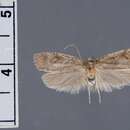Comprehensive Description
provided by Smithsonian Contributions to Zoology
Doina glebula
Alar expanse 20 mm.
Labial palpus sordid white, shaded and dusted with fuscous on outer side. Antenna grayish fuscous with very narrow paler annulations; scape fuscous. Head a mixture of grayish and white-tipped fuscous scales. Thorax a mixture of fuscous and grayish scales. Forewing ground color drab; costa marked with a series of short fuscous dashes and spots; at apical third two of the costal spots are longer than the remainder and are conspicuous; at basal third, in cell, a transverse fuscous dash; at end of cell an oblique transverse fuscous dash followed by a patch of brownish scales and between this and costa a grayish-fuscous suffusion forming an indistinct blotch; surface of wing with scattered fuscous irrorations; cilia composed of grayish white-tipped scales. Hind wing pale grayish fuscous; cilia sordid white with a darker subbasal line. Foreleg sordid white heavily overlaid fuscous; midleg similar; hind leg sordid white; tibia with slight grayish suffusion. Abdomen pale cinereous, dorsally overlaid with fuscous except posterior edges of segments; ventrally irrorate with fuscous.
Male genitalia slide USNM 24265. Harpe broadest at middle and heavily clothed with fine setae; cucullus rounded. Gnathos a broad, finely spined knob. Uncus divided. Vinculum rather narrowed distally and rounded. Tegumen about half as long as harpe; rectangular. Anellus a round plate with fleshy lobe basolaterally. Aedeagus rather stout, curved, pointed distally; vesica armed with one strong cornutus.
HOLOTYPE.—USNM 73710.
TYPE-LOCALITY.—Santiago, Rio Colorado.
Described from the unique male holotype (10 Apr 1953, L. E. Peña).
Although atypical by reason of its divided uncus, D. glebula nevertheless keys to this group. A different generic designation is indicated here but in the absence of more material I leave D. glebula in this genus.
Superficially, D. glebula resembles closely darker examples of the North American Agonopterix argillacea (Walsingham), but is immediately distinguishable structurally.
- bibliographic citation
- Clarke, J. F. Gates. 1978. "Neotropical Microlepidoptera, XXI : new genera and species of Oecophoridae from Chile." Smithsonian Contributions to Zoology. 1-80. https://doi.org/10.5479/si.00810282.273
Doina glebula: Brief Summary
provided by wikipedia EN
Doina glebula is a moth in the family Depressariidae. It was described by John Frederick Gates Clarke in 1978. It is found in Chile.
The wingspan is about 20 mm. The forewings are drab, the costa marked with a series of short fuscous dashes and spots. Two of the costal spots are longer than the remainder and are conspicuous at the apical third, while at the basal third, in the cell, is a transverse fuscous dash and at the end of the cell an oblique transverse fuscous dash is followed by a patch of brownish scales and between this and the costa a greyish-fuscous suffusion forms an indistinct blotch. The surface of the wing is scattered with fuscous irrorations. The hindwings are pale greyish fuscous.
- license
- cc-by-sa-3.0
- copyright
- Wikipedia authors and editors

